

Secondary Transition Guide - Home Page. Interagency Collaboration and Transition. "Collaboration is a way of thinking and relating, a philosophy, a paradigm shift, an attitude change.
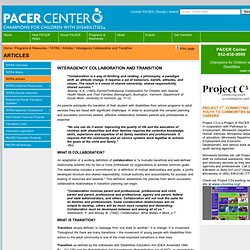
It requires a set of behaviors, beliefs, attitudes, and values. The result is a sense of shared ownership, shared responsibility, shared success. "-Bishop, K.K. (1993) Family/Professional Collaboration for Children with Special Health Needs and Their Families (Monograph), Burlington, Vermont: Department of Social Work, University of Vermont, pg. 11-12. As parents anticipate the transition of their student with disabilities from school programs to adult services they are faced with significant challenges. In order to accomplish the complex planning and successful outcomes desired, effective collaboration between parents and professionals is essential. Collaboration Profiles. Interagency Collaboration Annotated Bibliography. (prepared for NSTTAC by Valerie Mazzotti) As identified by Kohler's Taxonomy for Transition Programming, interagency collaboration is a primary component of "best practices" in secondary transition to promote positive post-school outcomes for students with disabilities (Kohler, 1993; Kohler, 1996).
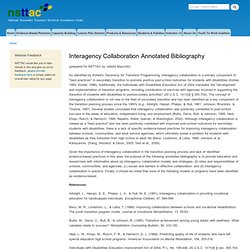
Additionally, the Individuals with Disabilities Education Act of 2004 mandates the "development and implementation of transition programs, including coordination of services with agencies involved in supporting the transition of students with disabilities to postsecondary activities" (20 U.S.C. 1411[d] § 300.704). The concept of interagency collaboration is not new to the field of secondary transition and has been identified as a key component of the transition planning process since the 1980's (e.g., Albright, Hasazi, Phelps, & Hull, 1981; Johnson, Bruininks, & Thurlow, 1987). References. 11 Effective Strategies. IFCTT Home Page. Community YouthMapping. Not only did it give me something productive to do over the summer months, but it opened up so many opportunities and possibilities for me.
It gave me more incentive to keep working for my community, especially for youth. I learned what the real world is like. I was able to interact with adults on a one-on-one basis. I improved my communication skills greatly and gained more self-confidence. AZ CTT Manual. Center for Effective Collaboration and Practice (CECP)
Interagency Agreement sample. Plan for Life after High School. NAPTAC. Cultural and Linguistic Diversity. Language Barrier In this chapter, you will learn about the language barriers that can exist for a parent who comes from another culture and has a child with a disability who is served in the special education system.

Research about language barriers will be presented along with María’s story. Things to Consider: 1. Imagine you are in a doctor’s office for a routine check-up. Language Barriers- What Research Says... Between the years 1980 and 2000, the U.S. population increased by one-fourth. Checklist to Facilitate Cultural Competence in Community Engagement. The Community Is the Key to Engaging Culturally and Linguistically Diverse Families - SEDL Letter, Putting the Public back into Public Schools, Volume XII, Number 1, May 2000. Home | SEDL Letter Archive by Kathleen Trail Published in SEDL Letter Volume XII, Number 1, May 2000, Putting the Public back into Public Schools Getting culturally and linguistically diverse families involved in education issues can ensure that all of a community's perspectives on education are included in the decision-making process.
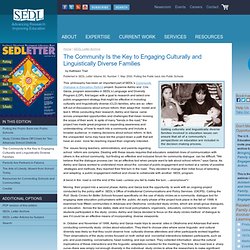
Raising Special Kids. The following is a listing of support groups or agencies that sponsor groups for families and individuals with disabilities and special health needs.
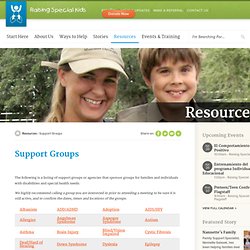
We highly recommend calling a group you are interested in prior to attending a meeting to be sure it is still active, and to confirm the dates, times and locations of the groups. Additional groups may be found at Community Information & Referral Services by visiting www.cir.org or calling 877-211-8661. Albinism NOAH - National Organization for Albinism and Hypopigmentation www.albanism.org In Arizona Contact: Cyndy Bensema, 602-995-1036 North West Valley CHADD (Maricopa County)Acacia Elementary School (Media Center)3021 W Evans Dr. in PhoenixDate: Fourth Tuesday of the Month7:00pm.
Center for Parent Information and Resources. Project C3 - Connecting Youth to Communities and Careers. Home. Seamless Transition Overview. Let's Talk About Seamless Transition The sequential delivery of specific preparatory and coordinated services that begin in early high school and that result in uninterrupted transition from public secondary education to employment and/or post-secondary education.
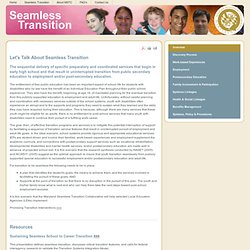
The entitlement of free public education has been an important aspect of school life for students with disabilities who by law have the benefit of an Individual Education Plan throughout their public school experience. They also have the benefit, beginning at age 16, of mandated planning for the eventual transition from this publicly supported education to employment and adult life. Unfortunately, without careful planning and coordination with necessary services outside of the school systems, youth with disabilities often experience an abrupt end to the supports and programs they need to sustain what they learned and the skills they may have acquired during their education. Promising Transition Interventions >>> Resources. Search NCSET, E-News, or the World Wide Web.
Partnerships in Employment.